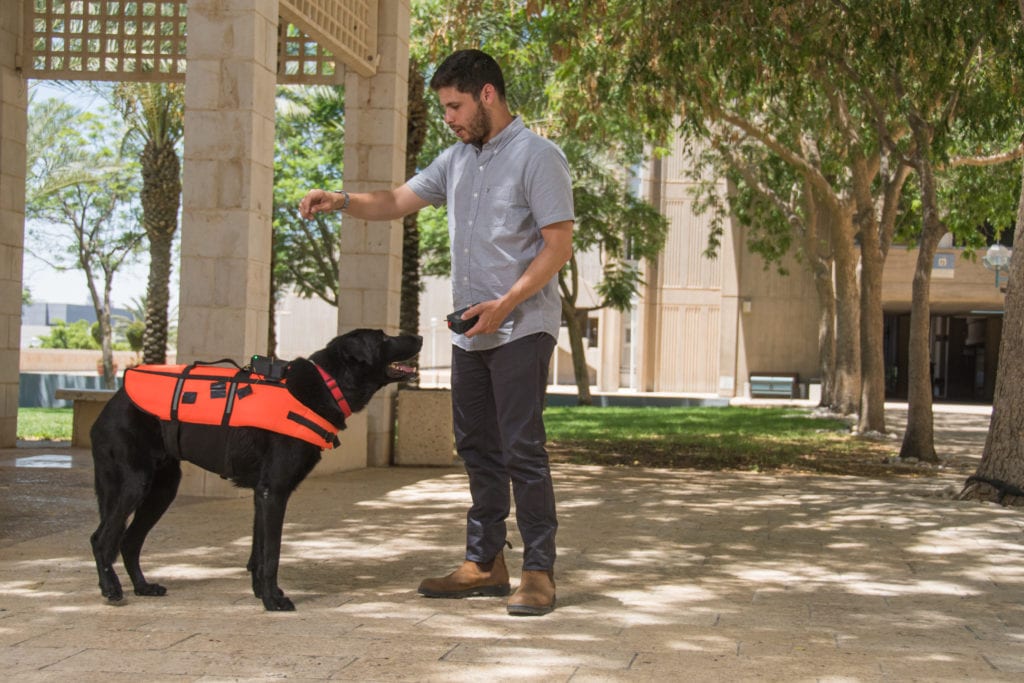Dogs are a man’s best friend, and they can be trained to carry out tasks and even to save lives. But suppose his owner is unable to speak or otherwise disabled? And what if the dog is needed for search and rescue in an environment too dangerous for his handler to enter but nevertheless has to be given commands?
The answer
Prof. Amir Shapiro, director of the robotics laboratory in the mechanical engineering department at Ben-Gurion University of the Negev (BGU) in Beersheba has devised an excellent solution. He reports that dogs can be trained to respond to haptic vibration commands while wearing a modified canine vest that he and colleagues developed. The technology simulates the senses of touch and motion, which are especially helpful in a remote operation or computer simulation where the user is not able to interact with and feel physical objects.
The power of touch
Haptics (from the Greek word haptikos) is any form of interaction involving touch. In haptic communication, people and animals can communicate via touching. Haptic technology – also known as kinesthetic communication or 3D touch – refers to any technology that can create an experience of touch by applying forces, vibrations or motions to the user.

This mechanical stimulation can be used to create virtual objects in a computer simulation, to control such virtual objects and to enhance the remote control of machines and devices. Haptic devices may incorporate tactile sensors that measure forces exerted by the user on the interface. Simple haptic devices are common in the form of game controllers, joysticks and steering wheels.
The majority of electronics offering haptic feedback use vibrations, and most use a type of eccentric rotating mass actuator consisting of an unbalanced weight attached to a motor shaft. As the shaft rotates, the spinning of this irregular mass causes the actuator, and in turn, the attached device, to shake.
Limitless capabilities
A dog wearing BGU’s commercially available fabric vest modified with vibration motors can be trained to sit, lay down, go to their handler or retrieve an object, depending on the vibrational command. A specific pattern can also be used to recall the dog from a distance.
The study, titled “Vibrotactile Vest for Remote Human-Dog Communication,” will be presented at the World Haptics Conferenceon July 12 in Tokyo.
“Our research results showed that dogs responded to these vibrotactile cues as well or even better than vocal commands,” said Shapiro. “Our current proof-of-concept study shows promising results that open the way toward the use of haptics for human-canine communication.”
The specs
The modified, commercially available mesh canine vest contains four small vibrating motors positioned over a dog’s back and sides that can be used to train or direct dogs to respond to different vibrations sent via wireless remote control. The handler can elicit different commands by controlling the site and duration of vibrations.
In the video below, Tai – a six-year-old Labrador retriever/German shepherd crossbreed – responds to several distinct commands, such as “spin,” “down,” “to me” or “backpedal.”

The haptic vest may also be used with existing dog training devices that detect posture and automate reward systems. “Integrating devices will allow us to further advance the potential of fully or partially autonomic dog training to assess general behavior, responsiveness to commands and the effectiveness of rewarding dogs for desired behavior,” added Shapiro.
The team
Shapiro’s team included Yoav Golan, a doctoral student in BGU’s Department of Mechanical Engineering, and Ben Serota, who earned his master’s degree in neuroscience at BGU and began this research as a graduate project for a “Haptic Sensing and Perception.” The team also includes Dr. Oren Shriki, head of BGU’s computational psychiatry lab in the department of cognitive and brain sciences. The research was supported by the Helmsley Charitable Trust for BGU’s Agricultural, Biological and Cognitive Robotics Initiative.
Future research will test the haptic vest technology on different breeds, ages and training experience, and will integrate more advanced devices into search and rescue, military work dog and service dog programs.





